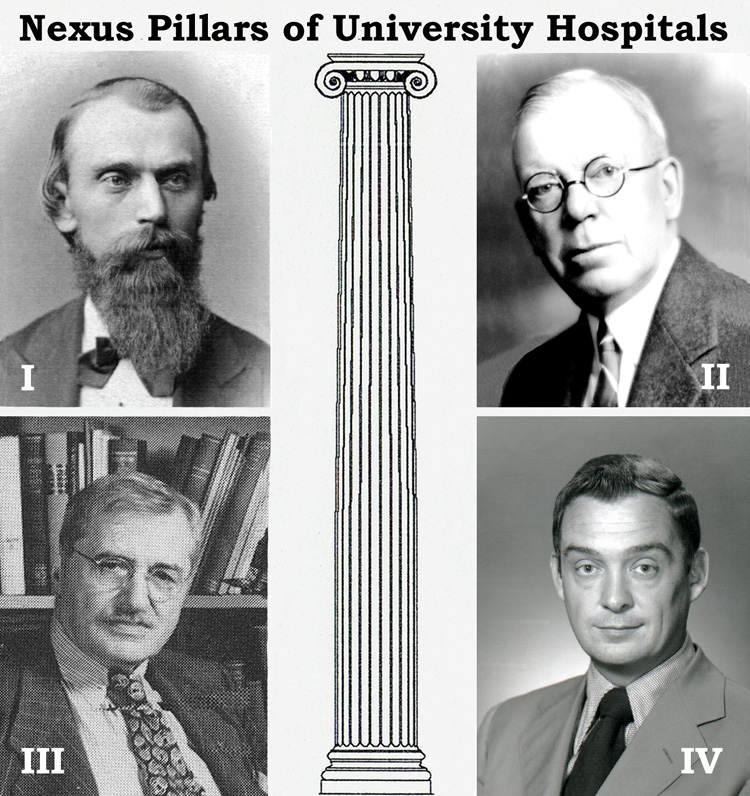
Among
those most responsible for today’s dynamic, widely-respected University
Hospitals are Gustavus Hinrichs (I),
William Boyd (II), Arthur Steindler (III) and John Colloton. The Hinrichs and
Colloton images courtesy UI Library Special
Collections; the Boyd image courtesy State Historical Society at Iowa City;
the author created the graphic.
|
By
Bob Hibbs
Iowa
City and University of Iowa Hospitals and Clinics present an apparent oxymoron
in the modern world of huge teaching hospitals.
Finding
such a stellar institution in a relative small town in a rural state is highly
improbable. Logically, it shouldn’t be; yet, it is. This billion-dollar
complex currently employs thousands and influences world-wide medical research
efforts in numerous specialties.
It
offers care and hope to Iowans whose local medical communities are no longer
capable of treating their afflictions. It sees patients from foreign lands who
respond to the implied promise of world-class care which U-Hospitals offers
them.
It
trains new physicians, nurses, pharmacists, medical technicians of every ilk
and countless others in such diverse vocations as nutrition, audiology, speech
therapy, sanitation and public health. Even dentistry is nearby.
Its
existence and stature emanate not from a single person or generation, nor any
single event. Rather, literally thousands have participated through nearly 150
years dating to the university’s infancy.
However,
if any one of four specific individuals had not provided dynamic leadership at
crucial times, then in all probability today’s institution would not exist,
or would be vastly inferior to its present lofty status in the world of
medicine.
The
nexus pillars are Gustavus Hinrichs, William Boyd, Arthur Steindler and John
Colloton.
Hinrichs
was UI’s first great science teacher. UI’s third building – 1866 North
Hall erected adjacent to Old Capitol – was built to house his classrooms and
laboratories. This European born and trained genius eventually became insane
and was fired; but, during his tenure he raised eye-brows along an
all-important eastern seaboard to quality science instruction at UI.
He
more than anyone convinced an early Iowa citizenry that despite competing
efforts of envious communities, the state’s medical school belonged in Iowa
City and deserved state funding.
Boyd
carried the unlikely title of financial chairman of the Iowa Board of
Education (now Regents) beginning in 1909 when U-Hospitals was headquartered
along Iowa Avenue during an era when growing efforts at national accreditation
nearly extinguished the UI medical school and hospital.
Boyd,
who is unrelated to a later UI president of similar name, believed quality
medical training could be made compatible with a small community in a rural
state. He worked tirelessly toward that goal while most despaired.
Ultimately,
Boyd convinced the giant Rockefeller Foundation to provide millions of dollars
during the 1920s to help finance an entirely new hospital west of the river.
It was opened in 1928 after he oversaw its planning, helped recruit resident
faculty and dampened friction among med school cliques.
Without
Boyd, the current hospital is inconceivable.
Arthur
Steindler, an orthopedic surgeon at UI and later Iowa City’s Mercy Hospital,
solved the problem of finding enough patients in a rural setting to permit
development of medical specialization. He sold a farmer-dominated Iowa
legislature on paying treatment costs in Iowa City for kids from throughout
the state, thus financing a children’s hospital.
This
“indigent care” program was expanded a half-decade later to include
adults, presaging the Medicaid program by decades. Without the early source of
patients provided by these state-funded programs, modern U-Hospitals
wouldn’t exist.
During
the 1960s, John Colloton found an updated 1928 physical plant in need of
replacement, as well as a critical need for staff development. The current
complex, including a section (or pavilion) named for him, speaks to his
decades-long contribution.
These
pillars had many supports; broad shoulders on which to stand; benefited from
tall cedars at their sides with brilliant faculty and staff delivering
outstanding services. Hundreds, even thousands, have made important
contributions through more than a century.
However,
without the nexus contributions of these individuals, in all probability the
hospital complex which so dominates the west university campus today would not
exist.
Next
Saturday:
Iowa City’s first tornado. Bob Hibbs collects local postcards and other historic ephemera and researches history related to them.
|